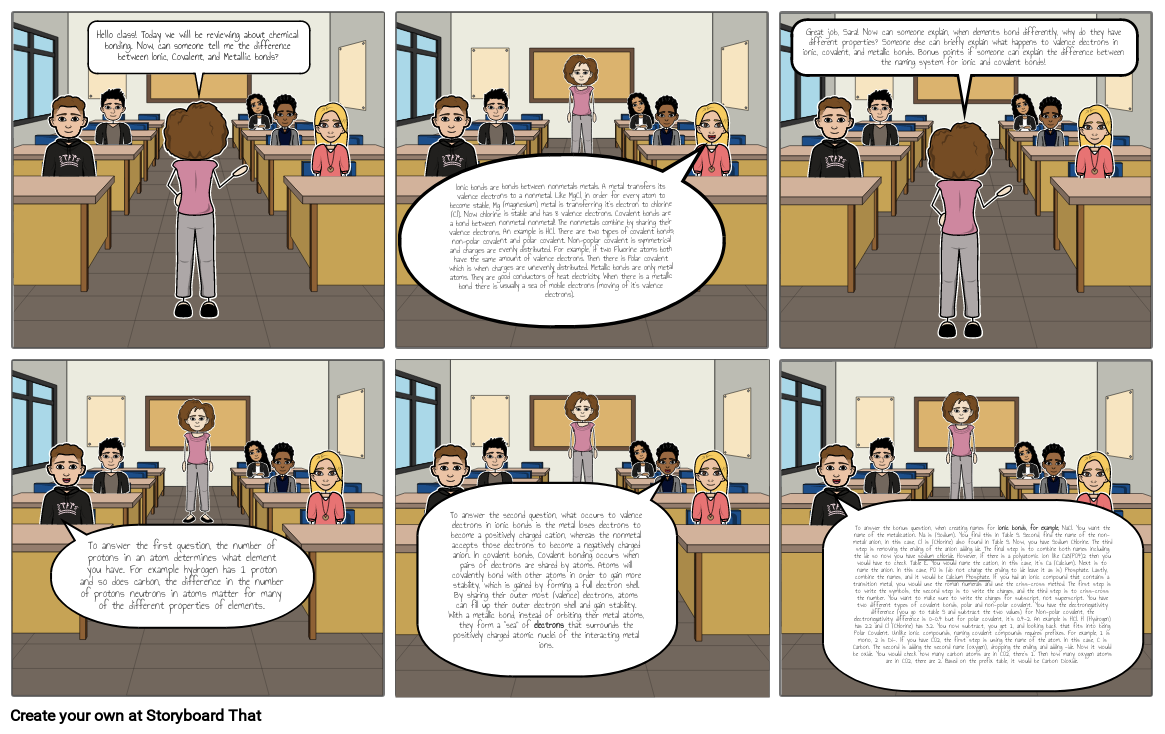Chemical Bonding ( La'Niyah Lee)

Öykü Penceresi Metni
- Hello class! Today we will be reviewing about chemical bonding. Now, can someone tell me the difference between Ionic, Covalent, and Metallic bonds?
- Ionic bonds are bonds between nonmetals metals. A metal transfers its valence electrons to a nonmetal. Like MgCl, in order for every atom to become stable, Mg (magnesium) metal is transferring it's electron to chlorine (Cl). Now chlorine is stable and has 8 valence electrons. Covalent bonds are a bond between nonmetal nonmetal! The nonmetals combine by sharing their valence electrons. An example is HCl. There are two types of covalent bonds; non-polar covalent and polar covalent. Non-poplar covalent is symmetrical and charges are evenly distributed. For example, if two Fluorine atoms both have the same amount of valence electrons. Then there is Polar covalent which is when charges are unevenly distributed. Metallic bonds are only metal atoms. They are good conductors of heat electricity. When there is a metallic bond there is usually a sea of mobile electrons (moving of it's valence electrons).
- Great job, Sara! Now can someone explain, when elements bond differently, why do they have different properties? Someone else can briefly explain what happens to valence electrons in ionic, covalent, and metallic bonds. Bonus points if someone can explain the difference between the naming system for ionic and covalent bonds!
- To answer the first question, the number of protons in an atom determines what element you have. For example hydrogen has 1 proton and so does carbon, the difference in the number of protons neutrons in atoms matter for many of the different properties of elements.
- To answer the second question, what occurs to valence electrons in ionic bonds is the metal loses electrons to become a positively charged cation, whereas the nonmetal accepts those electrons to become a negatively charged anion. In covalent bonds, Covalent bonding occurs when pairs of electrons are shared by atoms. Atoms will covalently bond with other atoms in order to gain more stability, which is gained by forming a full electron shell. By sharing their outer most (valence) electrons, atoms can fill up their outer electron shell and gain stability. With a metallic bond, instead of orbiting their metal atoms, they form a “sea” of electrons that surrounds the positively charged atomic nuclei of the interacting metal ions.
- To answer the bonus question, when creating names for ionic bonds, for example, NaCl. You want the name of the metal/cation. Na is (Sodium). You find this in Table S. Second, find the name of the non-metal/ anion, in this case, Cl is (Chlorine) also found in Table S. Now, you have Sodium Chlorine. The third step is removing the ending of the anion adding ide. The final step is to combine both names including the ide so now you have sodium chloride. However, if there is a polyatomic ion like Ca3(PO4)2 then you would have to check Table E. You would name the cation, in this case, it's Ca (Calcium). Next is to name the anion. In this case, PO is (do not change the ending to ide leave it as is) Phosphate. Lastly, combine the names, and it would be Calcium Phosphate. If you had an ionic compound that contains a transition metal, you would use the roman numerals and use the criss-cross method. The first step is to write the symbols, the second step is to write the charges, and the third step is to criss-cross the number. You want to make sure to write the charges for subscript, not superscript. You have two different types of covalent bonds, polar and non-polar covalent. You have the electronegativity difference (you go to table S and subtract the two values) for Non-polar covalent, the electronegativity difference is 0-0.4 but for polar covalent, it's 0.4-2. An example is HCl. H (Hydrogen) has 2.2 and Cl (Chlorine) has 3.2. You now subtract, you get 1, and looking back that fits into being Polar Covalent. Unlike ionic compounds, naming covalent compounds requires prefixes. For example, 1 is mono, 2 is Di-. If you have CO2, the first step is using the name of the atom. In this case, C is Carbon. The second is adding the second name (oxygen), dropping the ending, and adding -ide. Now it would be oxide. You would check how many carbon atoms are in CO2, there's 1. Then how many oxygen atoms are in CO2, there are 2. Based on the prefix table, it would be Carbon Dioxide.
30 Milyondan Fazla Storyboard Oluşturuldu

